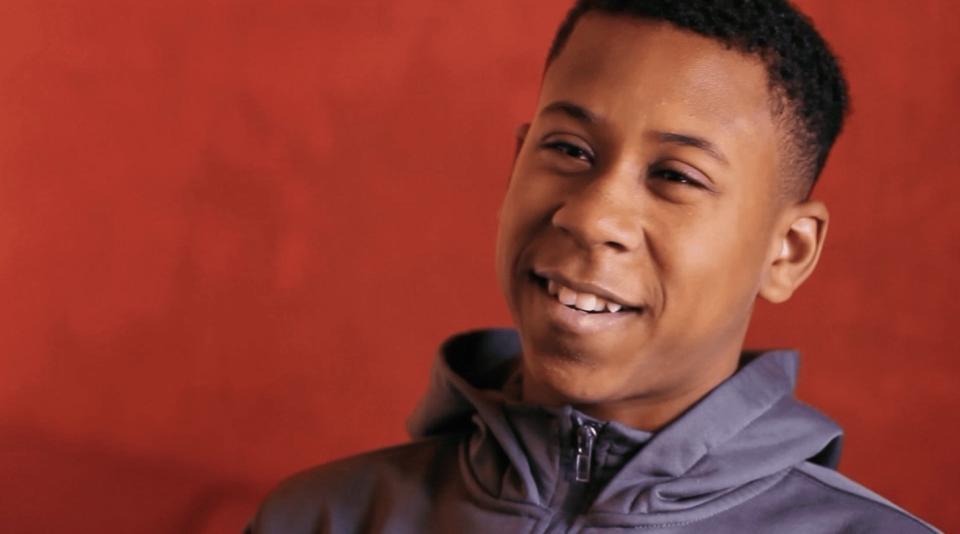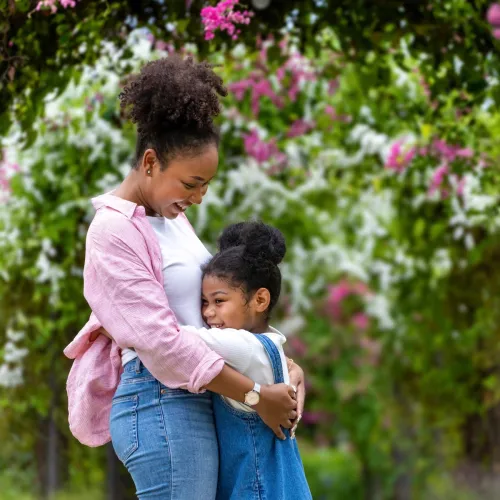How to Understand Your Child's Experience of Your Divorce
Have you ever wondered what’s going on in your kid’s hearts and minds, during or after your divorce… but also been a little afraid to ask?
Or maybe you’ve tried to ask them, but when you do, they either shut down or tell you, “I’m fine.”
Either way, you are not alone.
Divorce is draining, and it’s pretty common to feel overwhelmed and at a loss as to how to best handle your children’s emotions. Regardless, it is important to be there for them in this time of chaos and change.
So what can you do?
What if there was an easier way to understand your children’s experience and help them learn to talk about their emotions?
“We know how overwhelming, scary, and demanding it can be to parent children through divorce,” says Christina McGhee, educational director and content consultant for SPLIT and SPLIT UP, two films about children’s experiences of divorce. “It’s a big change in a family, and how parents manage it plays a significant role in how children get through it.”
This article explains simple, concrete things you can do in order to:
- Understand your child’s thoughts and feelings.
- Connect with your child, making them feel seen and heard.
- Teach them how to process and tolerate painful emotions.
- Feel closer to each other and feel less afraid of hard conversations.

Two gentle and heartfelt films can help you understand your kids’ experiences. SPLIT: The EARLY Years offers the stage to twelve kids ages 6- 12. SPLIT UP: The TEEN Years revisits these same kids ten years later as teenagers. The children in their documentary are genuine, forthcoming, and full of simple wisdom.
“Watching SPLIT and SPLIT UP is one huge step you can take towards those four goals,” says Ellen Bruno, producer, director, and editor. But this article isn’t just for SPLIT viewers. It’s for any divorced parents who want to feel empowered instead of helpless.
The very good news: It just takes one stable parent
Some co-parents feel powerless or at a loss when their kids are with their other parent, especially if communication is difficult between parents or there is tension between the households. “Often, a parent has no control over what happens at the other parent's home,” says Christina. “But it only takes one stable parent to give your child an anchor point they can rely on. You can create a home where they thrive—even in the midst of this tough time.”
“During your parenting time,” Christina explains, “you can help your kid build emotional coping skills they can take with them to their other parent’s house. This will not only help them now, while they’re responding to the divorce, but also help them build important life skills they can use whenever they face difficult experiences in the future.”
Ellen adds, “Calling upon your inner reserves of strength, even in tough times, is better for your mental health, too. Feelings of helplessness often bring along anger and bitterness. When you feel like you know how to tackle the situation, all three of those emotions can fade, leaving you with more emotional bandwidth to support your children.”
Bottom line: Focus on what you can control—it matters!

So, what are the SPLIT films and where do they fit in?
SPLIT is a documentary film that highlights 12 children whose parents recently divorced. “The kids are wise and funny, and they tell it like it is,” says Christina. “Their perspectives and stories can help parents really understand what it’s like to be a child of divorce.”
The second film, SPLIT UP, interviews these same kids 10 years later when they’re teenagers. We get to hear them reflect on the past and explain what life has been like since the divorce. (By the way, if your children are still young, SPLIT UP will offer you a glimpse into their future—while you still have time to influence it.)
Kids have lots of thoughts and feelings about divorce, but many don’t know how to express them. This is often true of parents, too! “SPLIT serves as a great jumping-off point to start these important conversations with your children,” explains Ellen.
These films can also help you make thoughtful changes, and they provide a lot of context for why those changes matter. But anyone can adopt some simple skills and make pragmatic choices, whether you watch the films or not.
8 simple skills and practical choices you can make to help your kids (with or without the films)
1. Raise your awareness.
This one is simple: Notice how your kids behave and act around you and around their other parent, and how they respond to the interactions between the two of you. “This may give you clues about what they’re feeling, but may not be sharing with words,” says Christina.
2. Take one small action toward change.
If you notice something about your child that doesn’t sit right with you, see if you can take one small action to approach it differently. “For example,” says Ellen, “How comfortable does your child feel talking about their other parent? When you mention your co-parent, does your child seem dejected, frustrated, or quiet afterwards? Maybe they need to be reassured it’s okay to talk about the other parent.”
You could say something like, “It’s okay to talk about Mom.” Or, “It’s okay to talk about spending time with Dad.” Although there may be times when it’s hard to hear what your kids have to say, giving them permission to share about life in their other home will make the transition much gentler for your child or teen.
3. Give them space to feel sad.
It is completely normal for children of divorce to experience a range of emotions, even intense sadness. Instead of feeling guilty about them feeling upset, do your best to help your child learn healthy ways to process these feelings.
When you can stand with your child in those moments, you have an opportunity to normalize and validate their feelings. If your child sees and feels that their emotional experience is understandable and makes sense, it can help them learn how to identify those feelings and trust themselves. Just like adults, kids spend a lot of time thinking no one else feels the way they do and dealing with their emotions in isolation—and that just intensifies a tough experience.
When possible, be your child’s container for the sadness.
What does it mean to be a container for your children? “When you can be fully present in the moment with your children and keep your own reaction or feelings at bay, it can be enormously helpful for your kids,” says Christina. “Basically, you are sending them the message that you are open and willing to accept and support those feelings. Instead of your children keeping them bottled up, you create a space where their emotions are safe and assure them that you are strong enough to handle those feelings. You also let them know that the love you have for them is unconditional.”
It can be incredibly difficult to really hear your child, especially when you’re worn out and anxious. “But we know you love your child,” says Ellen, “and this is a major way you can show that love and care.”
4. Teach your children to process their feelings.
Teach your children to process their emotions, not to fear them, avoid them, or push them down. Try these four steps:
- Help your child label their feelings.
Whether they’re feeling guilt, anger, grief, etc., help them figure out what the emotion is. Just by labelling their feelings, kids can reduce the intensity of those emotions. - Validate your child’s feelings.
Do your best to listen with empathy. Your children need to hear that their problems matter and their feelings make sense. (E.g., “Gosh, you really miss your Dad, and you miss the days we all spent together. Not having all the people you love in one place is hard! It makes sense that you feel sad about not seeing him today.”) - Normalize your child’s feelings.
Explain that many kids going through divorce feel the same way. (“This is where watching SPLIT with your children can come in handy,” says Christina.) Many children deal with divorce in isolation and think no one else could possibly feel the same way they do. Hearing the kids in SPLIT talk about their experiences may help your child not feel so alone. This step helps your child realize they’re normal and it’s okay to feel those feelings. - Teach your child distress tolerance skills.
One of the most helpful things you can teach your child in life is distress tolerance: the ability to tolerate difficult or uncomfortable emotions. This lesson is an incredible gift because even when your child experiences emotional pain, they don’t have to suffer as intensely.
“Divorce won’t be the only difficult experience in life your children encounter,” says Ellen. “While divorce is definitely hard, it can provide parents a valuable opportunity to equip their children with important skills to handle difficult times in the future.”
5. Don’t feel like you need to have it all figured out.
Some parents feel like they need the perfect words and complete self-control before having these tough conversations with their kids. “Not so!” says Christina. “Children know when you’re genuinely trying and can be very understanding. It’s also important to remember that we all mess up sometimes.
“If you make a mistake or say the wrong thing, you can always circle back to your kids. When you do, let them know that you wish you had handled the conversation differently and you are sorry for what you said. Then you can ask for a ‘redo’ or a ‘reframe’ and try again. Not only are you role-modeling how to handle missteps, but you’re also creating a great point of connection with your children.”
6. Get information and support.
The SPLIT films are one resource, but there are many other options. You can turn to friends, family, and other social supports. You might benefit from going to therapy or joining a support group. Or try reading one of our recommended books:
- Parenting Apart: How Separated and Divorced Parents Can Raise Happy and Secure Kids, by Christina McGhee
- How to Talk to Your Kids About Your Divorce: Healthy, Effective Communication Techniques for Your Changing Family, by Samantha Rodman
- Talking to Children About Divorce: A Parent's Guide to Healthy Communication at Each Stage of Divorce, by Jean McBride, MS LMFT
- The Truth About Children and Divorce, by Robert Emery PhD
- The Co-Parenting Handbook: Raising Well-Adjusted and Resilient Kids from Little Ones to Young Adults through Divorce or Separation, by Karen Bonell and Kristien Little
You can also subscribe to the OurFamilyWizard newsletter, which provides a monthly source of community, resources, and co-parenting guidance from experts in therapy and family law.
7. Watch SPLIT and/or SPLIT UP for yourself
Make time to watch one or both films when your kids aren’t around. “It’s crucial that you have time to have your own feelings and reactions to the film,” says Ellen. “Then, when you share the film with your kids, you can fully focus on them.”
You might choose to watch SPLIT with a friend or relative or a small group of divorced parents. Whether you watch alone or with others, if SPLIT stirs up feelings for you, know that’s normal. Then, find another adult to talk to. (Don’t turn to your kids for support. Kids naturally want to make things better when their parents are upset, but it’s not a burden they should bear.)
- Notice your feelings
“As you watch,” Christina suggests, “pay attention to the parts of the film that touch you deeply—and give yourself time to process these feelings. Be patient, and accept whatever you feel. Give yourself space to have an emotional reaction so that you can be calm and steady when you watch it with your kids. Get support if you need it.” (See #6.) - Stay open
Most of all, stay open to learning about your child’s experience—even if it surprises you and even if it hurts. “Remember,” says Ellen, “you don’t need to feel guilty. This exercise is to help you move forward thoughtfully, helping your children make it through the divorce in a healthy way.” - Reflect
After watching the film, take some time to reflect. Note which parts seemed like they might relate to your child’s experience, and think about how you can use that insight to better support your kids.
Several of the kids in SPLIT talk about wishing they understood what had happened between their parents. Consider spending some time evaluating how much you’re telling your child.
“When the question of “why?” comes up, answer it in a straightforward, age-appropriate way,” suggests Christina: “The idea you want to convey is: ‘Two good people don’t necessarily make a good couple. While we will no longer be partners, we will always be your parents.’ It’s also extremely important that you provide your children with a measured and balanced reason that doesn’t place all of the blame on one parent.’ Remember, kids need to be shielded from the intimate details of your relationship and adult information.
And if you’re wondering whether or not you should share something with your kids, it can help to ask yourself these three questions:
- How will this help my children?
- How will it change their relationship with their other parent?
- Do I want to share it because they need to hear it or because I feel like I need to say it?
To keep yourself on track, think about creating a guiding principle statement that articulates how you want to approach co-parenting—you can think of it as your north star when times are tough. To get started, consider: What matters most to you about co-parenting your children through divorce? How do you want to show up for your children during this time?

8. Watch SPLIT and/or SPLIT UP with your child or teen
Chances are, your children will relate to the SPLIT kids’ experiences of divorce. And kids listen to other kids differently than they listen to adults.
It comforts kids to see their many feelings, fears, and surprises mirrored by other kids. This can play a crucial role in normalizing the experience, as we talked about under #4. They also feel less isolated or alone.
“The films create an opportunity for kids to open up without having to directly talk about what’s happening in their family.” says Ellen. “They can just say, ‘I really liked when Ehryn said…’ Or, ‘I feel like Olivia in this part.’ It’s a much easier way to initiate conversations.”
- Ask gentle questions
If your child doesn’t start commenting, you can ask: “What do you think of that part?” - Take it slow
Don’t rush the conversation. - Listen
“Do more listening than talking,” says Christina. “You’re here to learn about your child’s experience.” - Keep talking
Follow your child’s lead, but if they’re comfortable, keep the conversation going! Encourage your child to talk by giving encouraging responses or asking follow-up questions to create a real discussion.
Let them get it out of their system. They’ll feel better, and you’ll be better prepared to help them move forward. - Be gentle to yourself—there’s no “perfect”
It’s normal to worry that you’ll say something wrong or respond in an unhelpful way. “But truly,” says Ellen, “having this conversation at all is a huge parenting victory!”
And if you do get something wrong, then you can circle back, acknowledge what went wrong, and explain how you’re going to do better moving forward. (Kids need to see that kind of responsibility and growth in action.)
Divorce is messy and complicated. Parenting is complicated, too. There’s no version of this conversation that goes “perfectly.” At the end, if your child feels safer being vulnerable, or feels more at peace with their emotions, or feels closer to you, then you’ve done a wonderful job.
Whether you watch SPLIT or not, you have the power to soften and support your child’s experience of divorce.
Your best resource is right there with you: Your child knows what they’re experiencing, and they just need some supportive guidance to get it all out there. When you simply sit there with them, feeling their emotions with them, it makes three powerful statements:
- It’s ok to feel strong emotions.
- Together, we’ll get through this.
- I love you no matter what.







